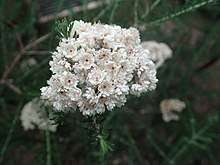Ozothamnus diosmifolius
Ozothamnus diosmifolius is an erect, woody shrub in the daisy family, Asteraceae and is endemic to eastern Australia. Common names for this species include rice flower, white dogwood, pill flower and sago bush. It has dense heads of small white "flowers" and is often used in floral arrangements.
| Rice flower | |
|---|---|
 | |
| Ozothamnus diosmifolius flowers | |
| Scientific classification | |
| Kingdom: | |
| (unranked): | |
| (unranked): | |
| (unranked): | |
| Order: | |
| Family: | |
| Tribe: | |
| Genus: | |
| Species: | O. diosmifolius |
| Binomial name | |
| Ozothamnus diosmifolius | |
| Synonyms[1] | |
| |
Description
Ozothamnus diosmifolius is an erect, much-branched, woody shrub which usually grows to a height of 2 m (7 ft) but sometimes much taller. Its branches are rough and densely covered with short hairs. The leaves are sharp-smelling, usually 10–15 mm (0.4–0.6 in) long and 1–2 mm (0.04–0.08 in) wide but inland forms have leaves to 3.5 mm (0.1 in) wide. As with other plants in the family Asteraceae, each "flower" is actually a head of flowers, each 2–3 mm (0.08–0.1 in) in diameter. In this species, the "flowers" are themselves arranged in corymbs, the corymbs in branching heads containing from a few to hundreds of individual "flowers". The white or pinkish coloration is due to the papery ray florets around individual "flowers".[2][3]
Taxonomy and naming
Rice flower was first formally described in 1804 by Étienne Pierre Ventenat who gave it the name Gnaphalium diosmifolium and published the description in Jardin de la Malmaison.[4][5] In 1838, Augustin Pyramus de Candolle changed the name to Ozothamnus diosmifolius.[6] The specific epithet (diosmifolius) is a reference to the similarity of the leaves of this species and those of Diosma.[7] The common names "rice flower" and "sago bush" refer to the appearance of the flowers in bud.[3]
Distribution and habitat
Ozothamnus diosmifolius is widespread on the coast, tablelands and western slopes of New South Wales and Queensland north from Eden to Wide Bay. It grows in heath and on rainforest margins, often on ridges.[2][3]
Ecology
The time of day of pollen release is different from that of stigma exposure, increasing the chances of cross-pollination.[3]
Cultivation
Prior to the mid-1980s, rice flower was extensively harvested from the wild for the cut flower trade. Following research on the species, commercial cultivation commenced in 1990 and by 1999 there were about 100 growers and exports, mainly to Japan, had increased to about 600,000 stems.[3]
Gallery
 O. diosmifolius buds
O. diosmifolius buds.jpg) leaves and flowers
leaves and flowers.jpg) pink form
pink form
References
- "Ozothamnus diosmifolius". Australian Plant Census. Retrieved 27 September 2019.
- Everett, Joy. "Ozothamnus diosmifolius". Royal Botanic Garden Sydney: plantnet. Retrieved 28 August 2017.
- Beal, Peter; Carson, Cynthia; Turnbull, Lois; Forsberg, Leif. "Rice Flower information kit" (PDF). Government of Queensland Department of Primary Industries. Retrieved 28 August 2017.
- "Gnaphalium diosmifolium". APNI. Retrieved 28 August 2017.
- Ventenat, Étienne Pierre (1804). Jardin de la Malmaison (volume 2). Paris: L. E. Hernan. pp. 74–75. Retrieved 28 August 2017.
- "Ozothamnus diosmifolius". APNI. Retrieved 28 August 2017.
- "Ozothamnus diosmifolius". Australian Native Plants Society (Australia). Retrieved 27 September 2019.
External links

